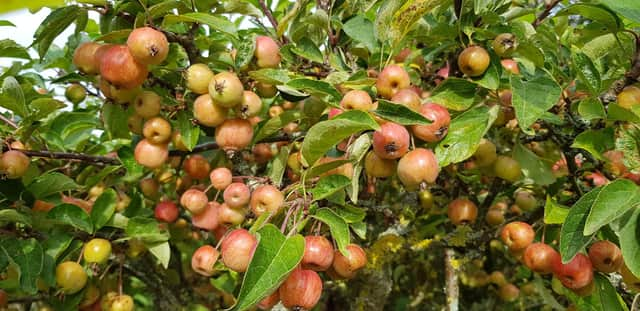GARDENING:


In a matter of weeks we`ll be into nature`s planting time, a period of semi dormancy for many woody perennials which makes it possible to lift and move them around in the garden or, to introduce something different that has caught the eye.
In this garden we have a range of shrubs that cover the four seasons with flowers, several of them fragrant. There are also those with variegated combinations of golden, silver, and green foliage, constantly attracting interest but most stunning in winter. That is when the paper white bark of birch lights up the border alongside red and pale green stems of dogwood.
Advertisement
Hide AdAdvertisement
Hide AdWhich brings us to the current display of ornamental fruits emanating from trees and shrubs. These were chosen not only for our entertainment but also that of any avian visitors. Their tasty treats began in springtime when golden racemes of Mahonia `Charity` turned into berries. Several berberis followed including the purple fruits of B. darwinii. Cotoneaster was on their menu but then our ripening strawberry crop became too big a distraction.
Autumn has refocused their attention on fruits attractive to us but daily bread to them. Two holly trees were laden with berries, were being the operative word. They`ve just started on a mountain ash (sorbus) bowing with fruits, and the pyracantha will be next.
When a flock of hungry birds descend on a garden they can strip a berry-laden tree rapidly, but ornamental crab apples and hip-bearing roses seem to appeal to their cautious nature as in, let`s save some for later. Walk around the Ornamental Garden at Alnwick in winter and there are still substantial bunches of `Red Sentinel` and `Evereste` crab apples in evidence.
Similarly, three favourite rose hip cultivars seem to survive the initial bird-feeding onslaught of winter. Just as well because I love the flagon-shaped hips of Rosa moyesii `Geranium,` the large rotund fruits of Rosa rugosa `Roseraie De L`Hay` and delightful clusters of Rosa glauca, and wouldn`t wish to spoil a good relationship by netting them!
Advertisement
Hide AdAdvertisement
Hide AdWe`ve never had cause to regret inviting birds into our garden. Yes, of course there`s the occasional blip in the relationship when they dust bathe in a row of emerging plant seedlings or overindulge on cultivated fruits, but on balance the garden would be a sad place without them.
So, how do you go about encouraging them to become practically resident throughout the four seasons? It begins with the provision of safe havens, places where they can roost overnight, find shelter from adverse weather, take refuge when there`s a predator around, and in many cases build a nest and raise a brood. In recent times, a family of wrens has spent winter nights roosting variously in their current nest, ivy on the house wall or a blue tit nesting box.
Evergreen or dense, deciduous hedges have a part to play, likewise ornamental trees and shrubs. A boundary fence need not remain bare. Cover it with climbers such as Ivy, clematis, honeysuckle, roses, et al.
As winter approaches spread organic mulch around the base of fruit trees and bushes, roses, and the diversity of ornamentals in a mixed border. This helps the plants but also encourages invertebrate life, some of which is a natural food source for the bird population. Nor should we be so hasty in removing the seed heads of spent blooms. They are responsible for our resident goldfinches. The winter-feeding station, bath, and fresh water supply simply helps cement our friendship.
Advertisement
Hide AdAdvertisement
Hide AdWhat do we get from the relationship? A free biological pest control service, constant entertainment, and companionship spring to mind. At the height of this past breeding season the ground was so dry that a blackbird and robin were almost sitting on the trowel as I dug holes to plant!